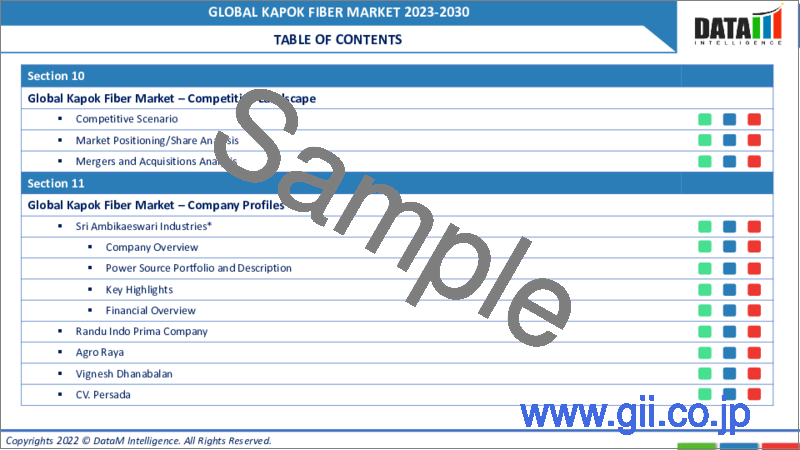|
|
市場調査レポート
商品コード
1272779
カポック繊維の世界市場-2023-2030Global Kapok Fiber Market - 2023-2030 |
||||||
カスタマイズ可能
適宜更新あり
|
|||||||
| カポック繊維の世界市場-2023-2030 |
|
出版日: 2023年05月15日
発行: DataM Intelligence
ページ情報: 英文 200 Pages
納期: 即日から翌営業日
|
- 全表示
- 概要
- 目次
市場概要
カポック繊維の世界市場規模は、2022年に7億2,600万米ドルと評価され、2030年には10億6,500万米ドルに達すると予測されます。同市場は予測期間(2023-2030年)にCAGR 4.9%で成長する見通しです。
カポック繊維は、枕、クッション、マットレスの製造に使用されます。柔らかく軽量な繊維で、低刺激性で温度調節に役立つため、寝具製品に最適です。主に東南アジアで栽培されています。カポック繊維は浮力があり、水に強いので、ライフジャケットなどの浮遊具に最適です。また、家具や車のシートなど、中綿が必要なもの張り地にも使用されています。カポック繊維は天然の断熱材であり、ジャケットや寝袋などの防寒具に使用されます。
市場力学
天然繊維の需要増がカポック繊維業界を牽引する
繊維産業は、環境への影響を軽減するために持続可能な手法を採用しています。Textile Exchangeのレポートによると、繊維産業における持続可能な繊維の使用は、2016年から30%増加しています。カポックのような天然繊維は、二酸化炭素排出量を削減し、環境に優しい製品への需要の高まりに応えたいと考えるメーカーの間で人気を集めています。天然繊維を使用したオーガニック衣料の需要が高まっているのです。
カポック繊維に関連する高コストがカポック繊維市場の成長を阻害している
カポックの木は熱帯地方に自生しており、カポック繊維の生産は数カ国に限られています。カポック繊維は、綿やウールなど他の天然繊維に比べ、供給量が限られているため、高価な繊維となっています。カポック繊維の収穫は、カポックポッドから手作業で繊維を取り出すという手間のかかる作業です。この工程がカポック繊維の生産コストに拍車をかけています。カポック繊維は、繊維から種やその他の不純物を取り除くための特別な加工技術が必要です。
COVID-19影響分析
COVID-19分析では、COVID前シナリオ、COVIDシナリオ、COVID後シナリオに加え、価格力学(COVID前シナリオと比較したパンデミック中・後の価格変動を含む)、需要-供給スペクトラム(取引制限、ロックダウン、その後の問題による需要と供給のシフト)、政府の取り組み(政府組織による市場、セクター、産業の活性化に関する取り組み)、メーカー戦略的取り組み(メーカーはCOVID問題を軽減するために何を行ったか)についても解説します。
目次
第1章 調査手法と範囲
- 調査手法
- 調査の目的と調査範囲
第2章 定義と概要
第3章 エグゼクティブサマリー
- 製品タイプ別
- アプリケーション別
- 地域別
第4章 市場力学
- 影響を与える要因
- 促進要因
- 繊維業界におけるカポック繊維の需要の高まり
- 天然繊維の需要の高まり
- 抑制要因
- カポック繊維に伴う高コスト
- 機会
- 環境配慮型製品への需要の高まり
- 影響分析
- 促進要因
第5章 業界分析
- ポーターのファイブフォース分析
- サプライチェーン分析
- 価格分析
- 規制分析
第6章 COVID-19の分析
- COVID-19)の分析
- COVID-19以前のシナリオ
- 現在の新型COVID-19のシナリオ
- 新型コロナウイルス感染症以降または将来のシナリオ
- 新型コロナウイルス感染症(COVID-19)の影響下における価格動向
- 需要と供給のスペクトル
- パンデミック中の市場に関する政府の取り組み
- メーカーの戦略的取り組み
- 結論
第7章 製品タイプ別
- 天然
- 合成
第8章 アプリケーション別
- 繊維およびアパレル
- 建築と建設
- 紙パルプ
- 家具
- その他
第9章 地域別
- 北米
- 米国
- カナダ
- メキシコ
- 欧州
- ドイツ
- 英国
- フランス
- イタリア
- スペイン
- その他欧州
- 南米
- ブラジル
- アルゼンチン
- その他南米
- アジア太平洋
- 中国
- インド
- 日本
- オーストラリア
- その他アジア太平洋地域
- 中東とアフリカ
第10章 競合情勢
- 競合シナリオ
- 市場ポジショニング/シェア分析
- 合併と買収の分析
第11章 企業プロファイル
- Daiwabo
- 会社概要
- 製品ポートフォリオと説明
- 財務概要
- 主な発展
- Randu Indo Prima Company
- Agro Raya
- Vignesh Dhanabalan
- CV. Persada
- Candra Kapok Factory
- PT. RajoJavaKapok
- Yunnan Honghe Panda
- Flocus
- Hi-Tech Fiber World
第12章 付録
Market Overview
The Global Kapok Fiber Market size was valued at US$ 726 million in 2022 and is projected to witness lucrative growth by reaching up to US$ 1,065 million by 2030. The market is growing at a CAGR of 4.9% during the forecast period (2023-2030).
Kapok fiber is used to make pillows, cushions and mattresses. It is a soft and lightweight fiber that is hypoallergenic and helps to regulate temperature, making it ideal for bedding products. It is primarily grown in Southeast Asia. Kapok fiber is buoyant and water-resistant, making it ideal for use in life jackets and other flotation devices. Kapok fiber is also used in upholstery for furniture, car seats and other items that require padding. Kapok fiber is a natural insulator and can be used in jackets, sleeping bags and other cold-weather gear.
Market Dynamics
The Increasing Demand for Natural Fibers is Driving the Kapok Fibers Industry
The textile industry is adopting sustainable practices to reduce its environmental impact. According to a report by the Textile Exchange, the use of sustainable fibers in the textile industry has increased by 30% since 2016. Natural fibers like kapok are becoming popular among manufacturers who want to reduce their carbon footprint and cater to the growing demand for eco-friendly products. The demand for organic clothing made from natural fibers is on the rise.
The High-Cost Associated with Kapok Fiber is Hampering the Kapok Fiber Market Growth
Kapok trees are native to tropical regions, and the production of kapok fiber is limited to a few countries. The limited supply of kapok fiber makes it expensive compared to other natural fibers like cotton and wool. The harvesting of kapok fiber is a labor-intensive process that involves manually extracting the fibers from the kapok pods. This process adds to the cost of producing kapok fiber. Kapok fiber requires special processing techniques to remove the seeds and other impurities from the fiber.
COVID-19 Impact Analysis
The COVID-19 Analysis includes Pre-COVID Scenario, COVID Scenario and Post-COVID Scenario along with Pricing Dynamics (Including pricing change during and post-pandemic comparing it with pre-COVID scenarios), Demand-Supply Spectrum (Shift in demand and supply owing to trading restrictions, lockdown, and subsequent issues), Government Initiatives (Initiatives to revive market, sector or Industry by Government Bodies) and Manufacturers Strategic Initiatives (What manufacturers did to mitigate the COVID issues will be covered here).
Segment Analysis
The global kapok fibers market is segmented based on product type, application, and region.
Based on Application, Natural Kapok Fiber Holds the Highest Market Share
The global kapok fiber market for natural product type was valued at US$ 663.3 million in 2022 and is estimated to grow at a CAGR of 5.21% during the forecast period (2023-2030) to reach US$ 993.1 million by 2030. Natural kapok fiber is a renewable and sustainable resource that is biodegradable and does not harm the environment.
As a result, the demand for natural kapok fiber is increasing due to growing consumer awareness about sustainability and environmental impact. Additionally, new natural fibers, recycled fibers, and science-based advances make up the three categories into which TLM Publishing Corp 2022 divides the breakthroughs. Some new natural materials are Kapok, seaweed, nettle and banana fibers that are used in knits, wovens and imitation leather.
Geographical Analysis
North America is Holding the Largest Market Share in the Kapok Fiber Market
The North American kapok fiber market was valued at US$ 103.5 million in 2022 and is likely to reach US$ 153.0 million by 2030, growing at a CAGR of 5.04% during 2023-2030. The driving factors for kapok fiber in the North American region are the growing demand for sustainable and eco-friendly products, increasing awareness about traditional fibers' environmental impact and kapok fiber's versatile properties.
Additionally, the growing popularity of natural and organic products and the increasing demand for non-toxic and hypoallergenic fibers could also contribute to the growth of kapok fiber in the North American region.
Competitive Landscape
The major global players include Daiwabo, Randu Indo Prima Company, Agro Raya, Vignesh Dhanabalan, and CV. Persada, Candra Kapok Factory, PT. RajoJavaKapok, Yunnan Honghe Panda, Flocus, and Hi-Tech Fiber World.
Why Purchase the Report?
- To visualize the global kapok fibers market segmentation based on product type and application and understand key commercial assets and players.
- Identify commercial opportunities by analyzing trends and co-development.
- Excel data sheet with numerous data points of kapok fibers market-level with all segments.
- PDF report consists of a comprehensive analysis after exhaustive qualitative interviews and an in-depth study.
- Product mapping available as Excel consisting of key products of all the major players.
The Global Kapok Fiber Market Report Would Provide Approximately 53 Tables, 48 Figures and 200 Pages.
Target Audience 2023
- Manufacturers/ Buyers
- Industry Investors/Investment Bankers
- Research Professionals
- Emerging Companies
Table of Contents
1. Methodology and Scope
- 1.1. Research Methodology
- 1.2. Research Objective and Scope of the Report
2. Definition and Overview
3. Executive Summary
- 3.1. Snippet by Product Type
- 3.2. Snippet by Application
- 3.3. Snippet by Region
4. Dynamics
- 4.1. Impacting Factors
- 4.1.1. Drivers
- 4.1.1.1. Rising demand for kapok fiber in the textile industry
- 4.1.1.2. The increasing demand for natural fiber
- 4.1.2. Restraints
- 4.1.2.1. High cost associated with kapok fiber
- 4.1.3. Opportunity
- 4.1.3.1. Growing demand for eco-friendly products
- 4.1.4. Impact Analysis
- 4.1.1. Drivers
5. Industry Analysis
- 5.1. Porter's Five Forces Analysis
- 5.2. Supply Chain Analysis
- 5.3. Pricing Analysis
- 5.4. Regulatory Analysis
6. COVID-19 Analysis
- 6.1. Analysis of COVID-19
- 6.1.1. Before COVID-19 Scenario
- 6.1.2. Present COVID-19 Scenario
- 6.1.3. PostCOVID-19 or Future Scenario
- 6.2. Pricing Dynamics Amid COVID-19
- 6.3. Demand-Supply Spectrum
- 6.4. Government Initiatives Related to the Market During the Pandemic
- 6.5. Manufacturers' Strategic Initiatives
- 6.6. Conclusion
7. By Product Type
- 7.1. Introduction
- 7.1.1. Market Size Analysis and Y-o-Y Growth Analysis (%), By Product Type
- 7.1.2. Market Attractiveness Index, By Product Type
- 7.2. Natural*
- 7.2.1. Introduction
- 7.2.2. Market Size Analysis and Y-o-Y Growth Analysis (%)
- 7.3. Synthetic
8. By Application
- 8.1. Introduction
- 8.1.1. Market Size Analysis and Y-o-Y Growth Analysis (%), By Application
- 8.1.2. Market Attractiveness Index, By Application
- 8.2. Textile & Apparel*
- 8.2.1. Introduction
- 8.2.2. Market Size Analysis and Y-o-Y Growth Analysis (%)
- 8.3. Building & Construction
- 8.4. Pulp & Paper
- 8.5. Furniture
- 8.6. Others
9. By Region
- 9.1. Introduction
- 9.1.1. Market Size Analysis and Y-o-Y Growth Analysis (%), By Region
- 9.1.2. Market Attractiveness Index, By Region
- 9.2. North America
- 9.2.1. Introduction
- 9.2.2. Key Region-Specific Dynamics
- 9.2.3. Market Size Analysis and Y-o-Y Growth Analysis (%), By Product Type
- 9.2.4. Market Size Analysis and Y-o-Y Growth Analysis (%), By Application
- 9.2.5. Market Size Analysis and Y-o-Y Growth Analysis (%), By Country
- 9.2.5.1. The U.S.
- 9.2.5.2. Canada
- 9.2.5.3. Mexico
- 9.3. Europe
- 9.3.1. Introduction
- 9.3.2. Key Region-Specific Dynamics
- 9.3.3. Market Size Analysis and Y-o-Y Growth Analysis (%), By Product Type
- 9.3.4. Market Size Analysis and Y-o-Y Growth Analysis (%), By Application
- 9.3.5. Market Size Analysis and Y-o-Y Growth Analysis (%), By Country
- 9.3.5.1. Germany
- 9.3.5.2. UK
- 9.3.5.3. France
- 9.3.5.4. Italy
- 9.3.5.5. Spain
- 9.3.5.6. Rest of Europe
- 9.4. South America
- 9.4.1. Introduction
- 9.4.2. Key Region-Specific Dynamics
- 9.4.3. Market Size Analysis and Y-o-Y Growth Analysis (%), By Product Type
- 9.4.4. Market Size Analysis and Y-o-Y Growth Analysis (%), By Application
- 9.4.5. Market Size Analysis and Y-o-Y Growth Analysis (%), By Country
- 9.4.5.1. Brazil
- 9.4.5.2. Argentina
- 9.4.5.3. Rest of South America
- 9.5. Asia-Pacific
- 9.5.1. Introduction
- 9.5.2. Key Region-Specific Dynamics
- 9.5.3. Market Size Analysis and Y-o-Y Growth Analysis (%), By Product Type
- 9.5.4. Market Size Analysis and Y-o-Y Growth Analysis (%), By Application
- 9.5.5. Market Size Analysis and Y-o-Y Growth Analysis (%), By Country
- 9.5.5.1. China
- 9.5.5.2. India
- 9.5.5.3. Japan
- 9.5.5.4. Australia
- 9.5.5.5. Rest of Asia-Pacific
- 9.6. Middle East and Africa
- 9.6.1. Introduction
- 9.6.2. Key Region-Specific Dynamics
- 9.6.3. Market Size Analysis and Y-o-Y Growth Analysis (%), By Product Type
- 9.6.4. Market Size Analysis and Y-o-Y Growth Analysis (%), By Application
10. Competitive Landscape
- 10.1. Competitive Scenario
- 10.2. Market Positioning/Share Analysis
- 10.3. Mergers and Acquisitions Analysis
11. Company Profiles
- 11.1. Daiwabo*
- 11.1.1. Company Overview
- 11.1.2. Product Portfolio and Description
- 11.1.3. Financial Overview
- 11.1.4. Key Developments
- 11.2. Randu Indo Prima Company
- 11.3. Agro Raya
- 11.4. Vignesh Dhanabalan
- 11.5. CV. Persada
- 11.6. Candra Kapok Factory
- 11.7. PT. RajoJavaKapok
- 11.8. Yunnan Honghe Panda
- 11.9. Flocus
- 11.10. Hi-Tech Fiber World
LIST NOT EXHAUSTIVE
12. Appendix
- 12.1. About Us and Services
- 12.2. Contact Us





